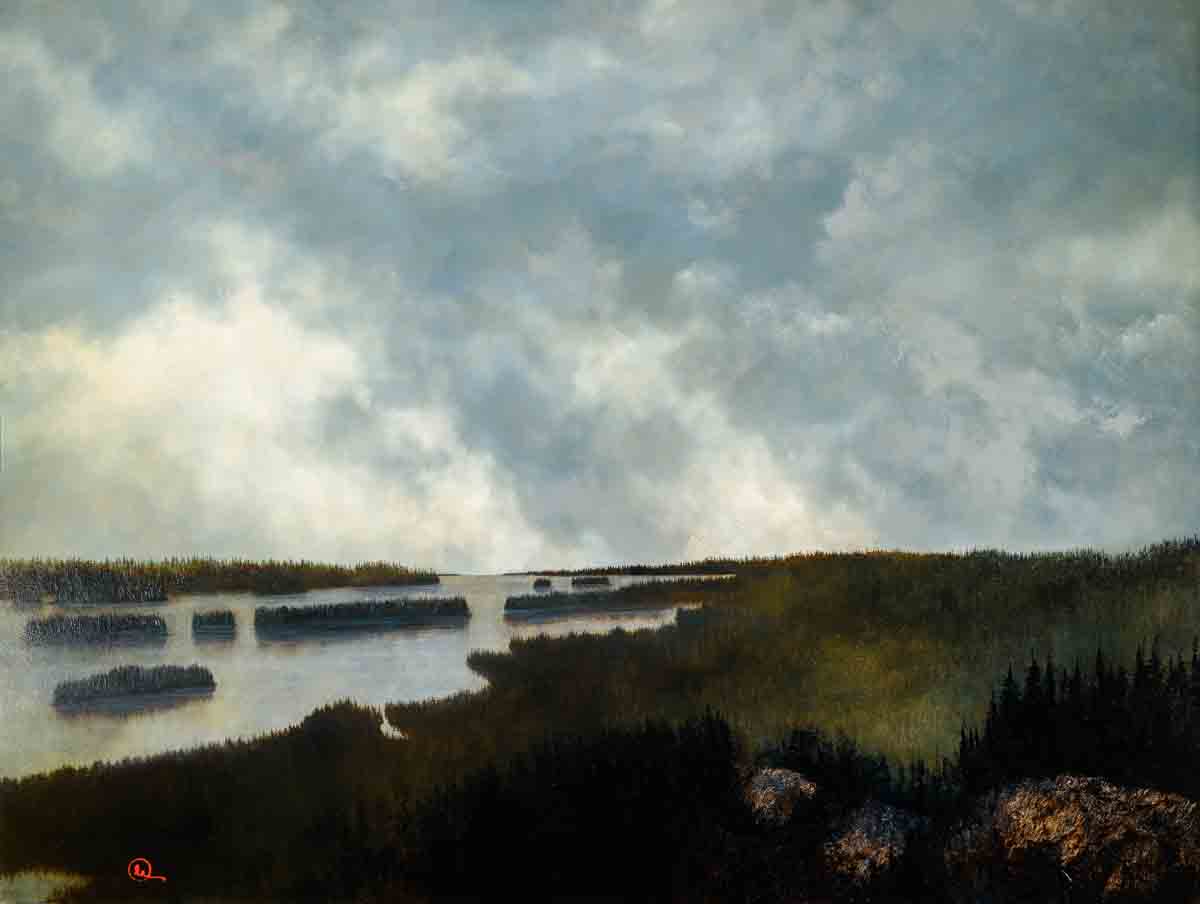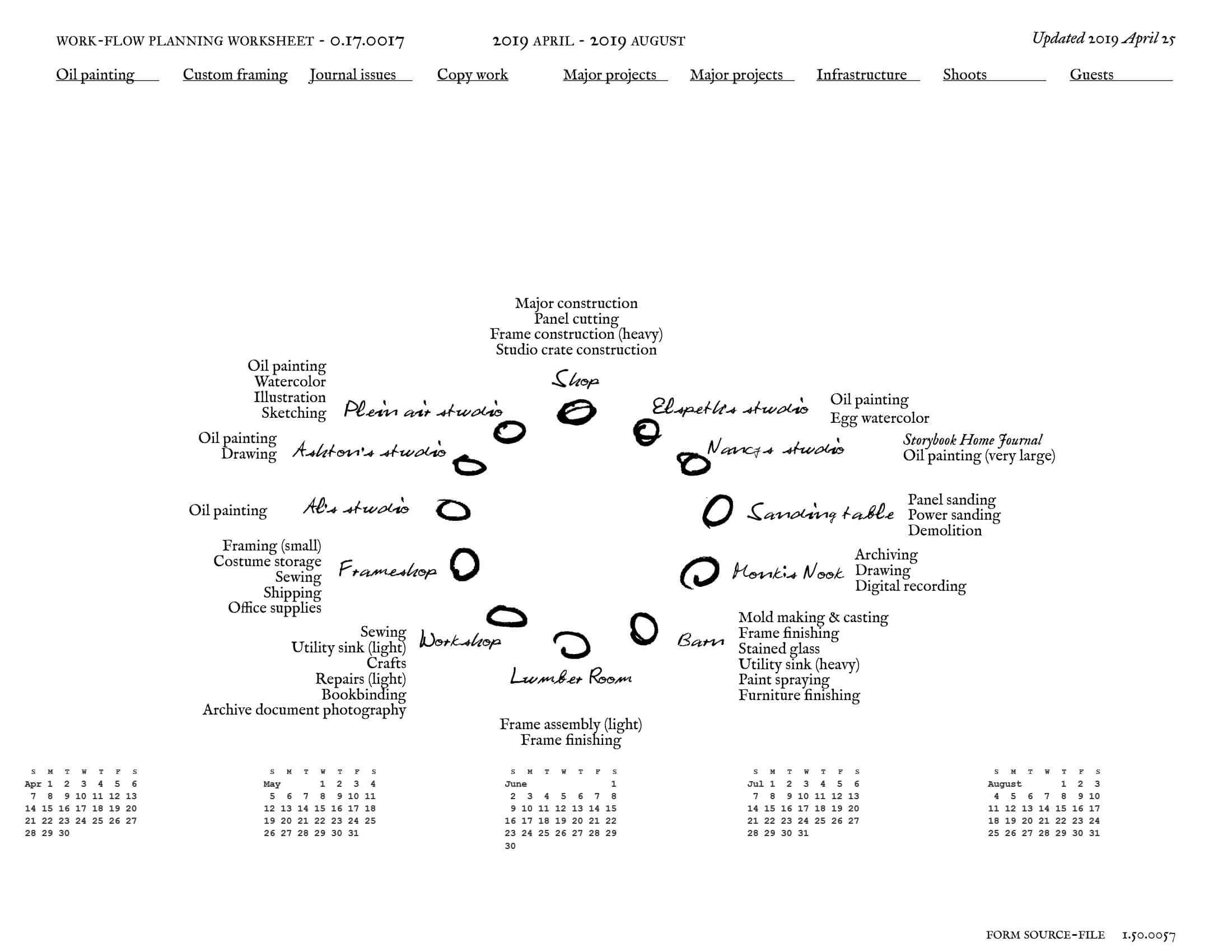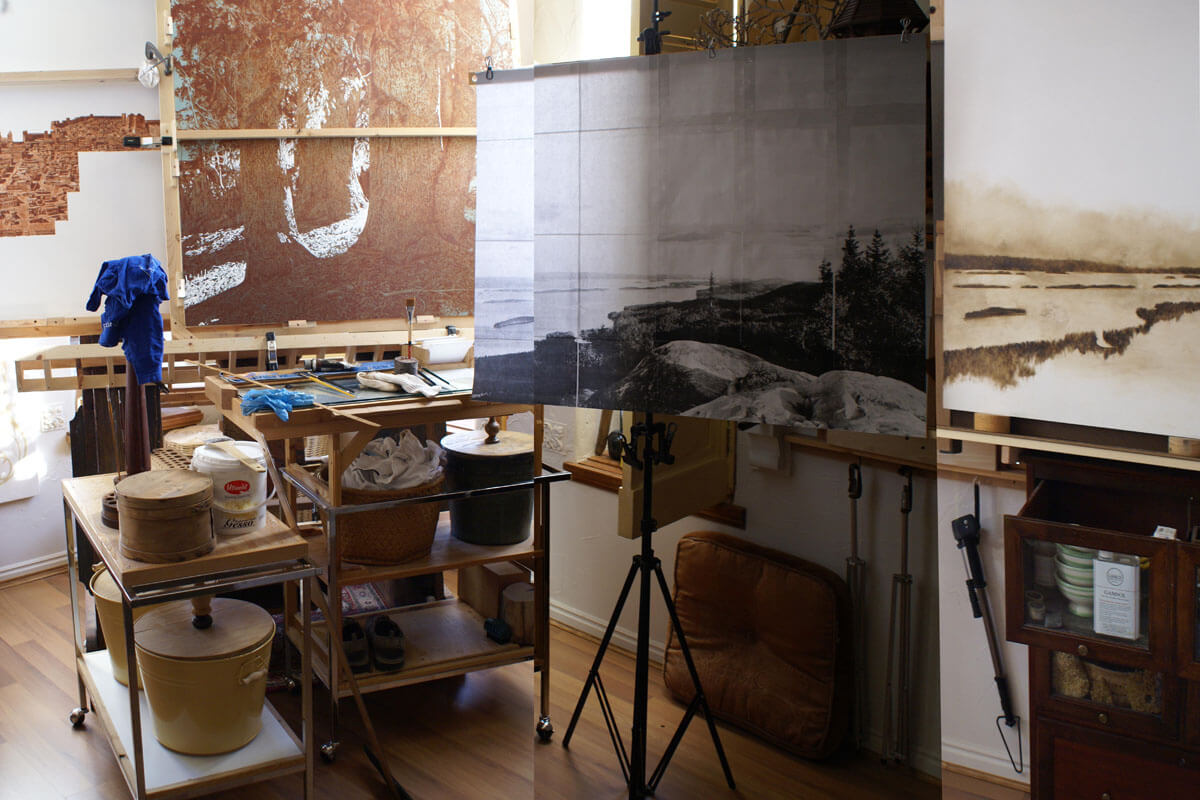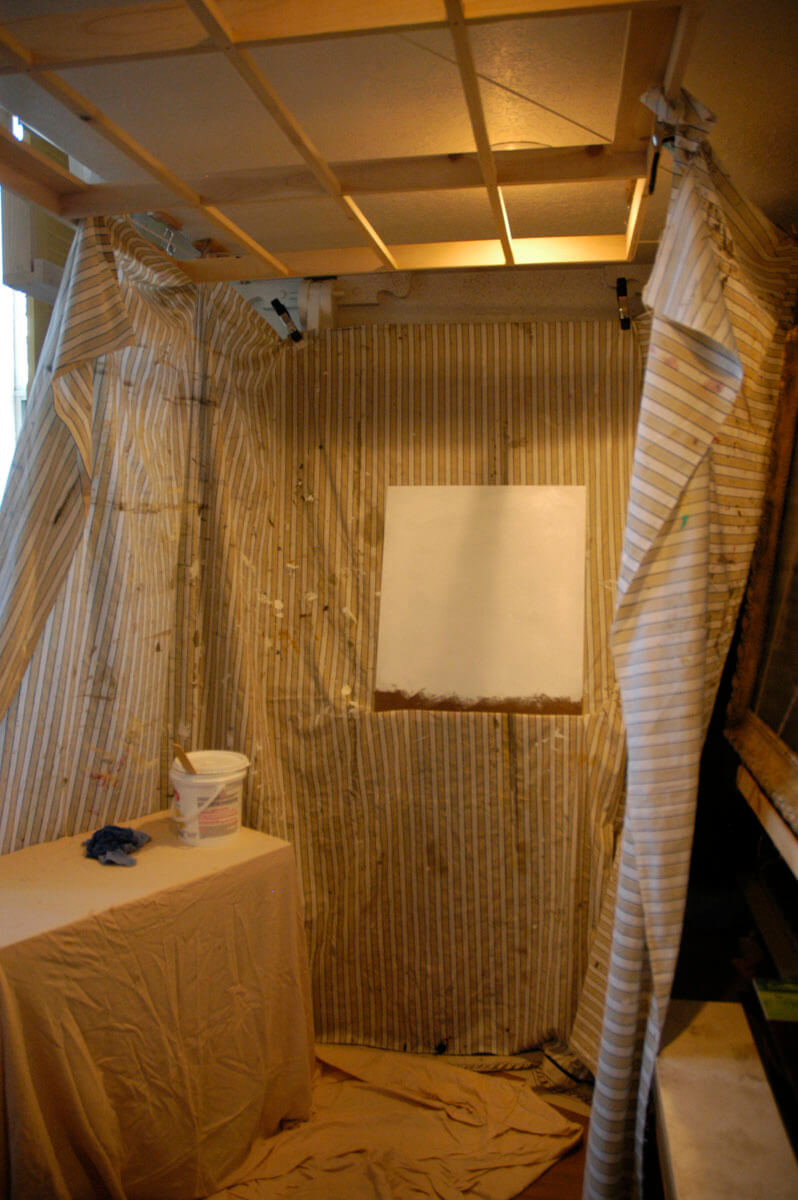Yachting, inconveniences and studio workflow
By Al R. Young
 |
| Everenne Jurevanne (Under the Northern Mountains) by Al R. Young |
This handmade, original oil painting was created by the artist in the studios at Ben Haven.
It is part of The Isles of Rune Project, an ongoing creative endeavor of the Artists of Al Young Studios.
Read more . . .
It is part of The Isles of Rune Project, an ongoing creative endeavor of the Artists of Al Young Studios.
Read more . . .
milestones
Composition finalized — 2017 February
Brushwork begins — 2017 March
Painting completed — 2017 August
Based on regular entries in the project journal for this painting, creation of the artwork involved approximately 25 sessions (from composition and panel preparation to completion of brushwork).
equipment created or modified for this project
None.
dimensions (unframed width x height)
46 7/8 in. x 35 5/8 in.
support
Panel
costumes, miniatures, and props created for this project
None.
methodology
In The Palm Beach Story (1942), directed by Preston Sturges, John D. Hackensacker III (Rudy Vallée) and Geraldine Jeffers (Claudette Colbert) are aboard Hackensacker's yacht when the steward approaches them with the question of whether they wish to dine on deck or in the saloon. The couple have only recently met and Geraldine has never been aboard a yacht. Hackensacker, anxious to please his bright-eyed guest nevertheless wryly explains: "We can have it on deck if you like, but it blows everything all over the place. There are a lot of inconveniences to yachting that most people don't know anything about." Like yachting, there are a lot of things about being a studio artist that most people know nothing about.
I suspect, for example, that "most people" think—if, indeed, they think about it at all—that configuring a studio is like configuring a living room and that, once configured, maintenance might equate to cleaning one's office or perhaps a closet. For me, studio configuration is an ongoing conundrum that varies according to
• Kind and diversity (mutual compatibility) of the media involved in the work of the studio
• Kind and quality of light required
• Number of active studio projects to be accommodated at any given time
• Where those projects are likely to be, concurrently, at any given time in their development
• Size of the projects
• Degree to which the studio is or is not isolated from the rest of the household
• Extent to which climate or weather requires enclosure
• Square footage and height of studio workspace(s)
Then there are considerations of electricity, heating, cooling, dust and particulates, clean-up, storage of equipment and supplies, storage of artworks, storage of costuming and props; not to mention all of the support services associated with the business operation of a studio, from accounting and marketing to research and shipping.
A "studio" is not "a" space, but a configuration of spaces, in which each space is also configured. Some functions can overlap in the same space because they do not occur concurrently or because the space is large enough for multiple projects to be left in place concurrently. Some activities cannot overlap, regardless of space, because the overlap would be hazardous to the projects themselves or to people in the space. Many factors have to be reconciled. And something in the equation of it all is always changing.
This article features something we created with the catchy title of Workflow Planning Worksheet. One of the simple, primary objectives in formulating this tool was to ensure that toxic materials, pungent odors, noise, and unsightliness were separate from living spaces as well as from other work areas and the people in them. Nearly forty years ago, "the studio" was one mansard room in a small condo and the only activities the space had to accommodate were pencil drawing, writing, and the simple business functions of a very modest start-up venture. Now, "the studio" includes two painters, another artist specializing in stained glass and ceramics, another artist specializing in musical composition and photography, and yet another artist whose work centers around The Storybook Home Journal , which currently translates into an office area in a studio loft as well as a kitchen and pantry. One of the painters in this Rubik cube works in what might be considered one studio and two half-studios—one of the halves is part of a library and the other half is kind of time-share in a plein air studio. The other painter works primarily in one studio plus part-time in the plein air studio. The stained glass artist works in yet another indoor studio, set aside primarily for two-dimensional projects, while the stained glass and ceramics are housed in a garden structure known quaintly as the barn. The composer-photographer in residence has one studio indoors, which also doubles in accommodating business and information technology (IT) functions. Support services and diverse activities overlapping among these studios and other locations are plotted on the Workflow Planning Worksheet, which we update infrequently and only in general terms, lest maintenance of the form constitute a full-time job. (Maintenance of the form focuses almost exclusively on avoiding log jams among projects.)
The form does not include all the living and business functions involved in some of the spaces listed. I used to wonder why in the world Maxfield Parrish needed a studio consisting of fourteen rooms. I no longer wonder.
 |
| The basic worksheet, sans project detail, which is listed in the blank space across the top of the form. |
In the diagram at the center of the worksheet, not all the spaces are separate rooms. Nor are all studio functions represented; instead, the worksheet only focuses on those activities with a significant spatial footprint in areas that must accommodate multiple functions, sometimes concurrently. For example, photo shoots, IT services, library and research, cooking, gardening, and storage (costume, equipment, supplies, artworks) do not figure in the diagram because the spaces in which they occur are not home to the kinds of activities the worksheet was designed to coordinate.
The following images illustrate, among other things, the use of one of the studios in which easels house several projects at different stages of completion, the balance between stationery and portable equipment, and the use of dropcloths as temporary partitions.
 |
| This photograph shows the studio at the end of the first painting session for the monochromatic underpainting of Everenne Jurevanne. The $10 easel is at the back of the image with two large paintings on it. The trestles on which those panels rest allow the paintings to be positioned horizontally and vertically apart from each other. Everenne Jurevanne is on the wall easel at right (in the photograph) because the light there is poor and the underpainting, being monochromatic, doesn't require the light for which the $10 easel is positioned. The carts can be configured for work anywhere, and also provide storage space. A copy of the composition for Northern Mountainsis clamped to a light stand that collapses for storage. |
 |
| This is one of the studio carts and the same wall-mounted easel pictured in the foregoing photograph (on which Northern Mountains rests). This configuration of the studio uses that easel for applying layers of gesso, without splattering any of the other projects in the space. Another wall-mounted easel, at right in the photograph, is protected by the dropcloth clamped to the wood frame suspended from the ceiling. |
For more about studio workflow, see Snapshot of an artist's workflow
Tags: Under The Northern Mountains, 2019, Project commentaries
Browse articles by year: 2025 . 2024 . 2023 . 2022 . 2021 . 2020 . 2019 . 2018 . 2017 . 2016 . 2015 . 2014 . 2013 . 2012 . 2011 . 2010 . 2009 . 2008 . 2007 . 2006 . 2005 . 2004 . 2003 . 2002 . 2001 . 2000 . 1999 . 1998 . 1997 . 1996
Browse articles by topic: Art lessons . BenHaven Archives . Blank art diaries . Fine art photography . Framing . Illustration . Inspiration and creativity . Isles of Rune . Limited Editions Collection . My Fathers Captivity . News . Novellas . Oil paintings and prints . Operations announcements . Orders and shipping . Overview . Portfolios . The Papers of Seymore Wainscott . Project commentaries . Recipes by Nancy Young . Recommended reading . Recommended viewing . Temple artworks . The Storybook Home Journal . Tips and techniques . Tools supplies and operations
Browse articles by topic: Art lessons . BenHaven Archives . Blank art diaries . Fine art photography . Framing . Illustration . Inspiration and creativity . Isles of Rune . Limited Editions Collection . My Fathers Captivity . News . Novellas . Oil paintings and prints . Operations announcements . Orders and shipping . Overview . Portfolios . The Papers of Seymore Wainscott . Project commentaries . Recipes by Nancy Young . Recommended reading . Recommended viewing . Temple artworks . The Storybook Home Journal . Tips and techniques . Tools supplies and operations